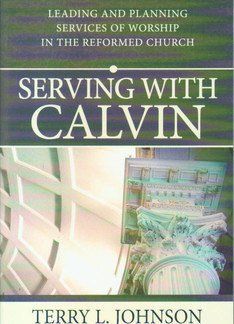Serving with Calvin is a sequel to the author’s earlier work, Worshipping with Calvin, in which he argued for ‘the historic ministry and worship of Reformed Protestantism’. In this later book, he sets out to show us how to do it.
There is much that is helpful. An introductory chapter surveys the church scene and argues for the centrality of the Lord’s Day services. These should be marked by God-centred reverence, targeted at the community as a whole, focused on the ordinary means of grace and dependent on the Holy Spirit.
A short chapter on the need for the minister himself to be prepared follows, which is suitably thought-provoking. A slightly longer chapter deals with the overall arrangement of a typical Lord’s Day service, based on the principles set out in the introductory chapter. The author argues that church leaders should aim for excellence in every part of the service.
By far the longest section of the book comprises two chapters with the title ‘Administering the elements’. The first of these deals with the public reading of Scripture, advocating consecutive Bible readings from both Testaments. Advice is also given on how the Scriptures should be read. Seventy-seven pages are then spent exploring preaching. These contain useful and thought-provoking discussion on ‘Christocentric’ preaching.
The following chapter deals with public prayers, Psalms and hymns, and the administration of the ordinances. In particular, the first two of these topics, his advice is immensely helpful, with strong emphasis on the centrality of Scripture.
The chapter, ‘Preparing the setting’ addresses such matters as church architecture, the place of religious art, the use of modern technology, the need for the congregation to be friendly towards visitors, and the upkeep of premises. Coverage is indeed comprehensive.
The closing chapters consider how to introduce changes along the lines advocated by the author, mistakes to avoid, and how Bible-based worship will benefit the next generation.
The title of the book is unfortunate, giving as it does the impression of advocating doing things in a certain way simply because Calvin did. However, the author’s thesis is that the style of worship rediscovered by Calvin at the time of the Reformation is biblical worship. Moreover, there is little reference to Calvin himself throughout the book.
The book is written from an American perspective, and so addresses issues that are less relevant to the UK scene. Also, Baptist readers will have to bear with the author’s paedobaptist views.
Thirdly, there are several instances where the author concedes that he has no biblical warrant for his position on a certain point (the frequency of the Lord’s Supper, for example), but defends his view simply on the grounds of ‘wisdom’, which is not always entirely convincing. Finally, there is a disappointing number of typographical errors which mar what is otherwise a good-quality publication.
Notwithstanding these niggles, this is a book well worth reading, particularly by church leaders. It forms a valuable and cogent defence of conservative, Bible-centred worship.
David Cooke
Banbury
ry





